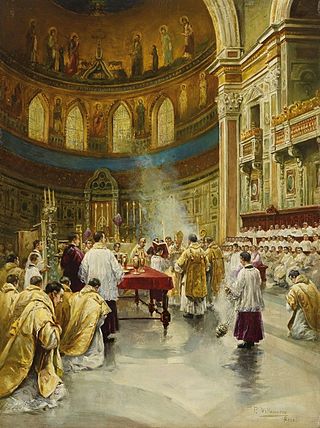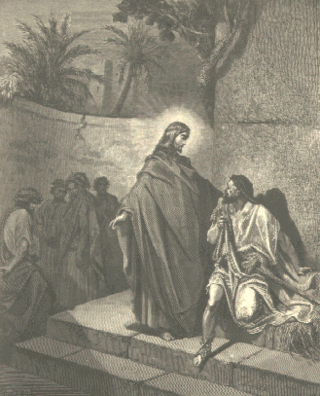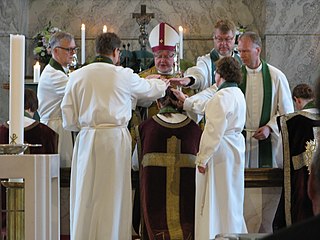
Anointing of the sick, known also by other names such as unction, is a form of religious anointing or "unction" for the benefit of a sick person. It is practiced by many Christian churches and denominations.
In some religions, an exorcist is a person who is believed to be able to cast out the devil or performs the ridding of demons or other supernatural beings who are alleged to have possessed a person, or (sometimes) a building or even an object. An exorcist can be a specially prepared or instructed person including: priest, a nun, a monk, a witch doctor (healer), a shaman, a psychic or a geomancer.

Emmanuel Milingo is an excommunicated former Roman Catholic archbishop from Zambia. He was ordained in 1958; in 1969, aged 39, Milingo was consecrated by Pope Paul VI as the bishop of the Archdiocese of Lusaka. In 1983, he stepped down from his position as Archbishop of Lusaka after criticism for exorcism and faith healing practices that were not approved by church authorities. In 2001, when Milingo was 71, he received a marriage blessing from Sun Myung Moon, the leader of the Unification Church, despite the prohibition on marriage for ordained priests. In July 2006, he established Married Priests Now!, an advocacy organization to promote the acceptance of married priests in the Roman Catholic Church.
Whare Ra is the name of a building in Havelock North in the Hawkes Bay region of New Zealand. The building housed the New Zealand branch of the magical order the Stella Matutina. It was designed and the construction overseen by one of New Zealand's most famous architects, and a senior member of the Order, James Chapman-Taylor.
A churchwarden is a lay official in a parish or congregation of the Anglican Communion or Catholic Church, usually working as a part-time volunteer. In the Anglican tradition, holders of these positions are ex officio members of the parish board, usually called a vestry, parochial church council, or in the case of a Cathedral parish the chapter.

The Chrism Mass is a religious service held in certain Christian denominations, such as Roman Catholicism, Lutheranism, and Anglicanism. It is usually celebrated each year on Maundy Thursday or on another day of Holy Week. During the ceremony, the holy oils used for sacraments and rituals are blessed or consecrated.

Exorcism is the religious or spiritual practice of evicting demons, jinns, or other malevolent spiritual entities from a person, or an area, that is believed to be possessed. Depending on the spiritual beliefs of the exorcist, this may be done by causing the entity to swear an oath, performing an elaborate ritual, or simply by commanding it to depart in the name of a higher power. The practice is ancient and part of the belief system of many cultures and religions.

The Cathedral Church of Saint Matthew, known simply as St. Matthew's Cathedral, is an Episcopal cathedral church located at 5100 Ross Avenue in Dallas, Texas, in the United States.
In keeping with its prevailing self-identity as a via media or "middle path" of Western Christianity, Anglican sacramental theology expresses elements in keeping with its status as a church in the catholic tradition and a church of the Reformation. With respect to sacramental theology the Catholic tradition is perhaps most strongly asserted in the importance Anglicanism places on the sacraments as a means of grace, sanctification and forgiveness as expressed in the church's liturgy.
The Stella Matutina was an initiatory magical order dedicated to the dissemination of the traditional occult teachings of the earlier Hermetic Order of the Golden Dawn. Originally, the outer order of the Stella Matutina was known as Mystic Rose or Order of the M.R. in the Outer. When occult writer Israel Regardie released documents of the Golden Dawn to the public it was the teachings of the Stella Matutina that he revealed, not those of the original order. The Stella Matutina was one of several daughter organisations into which the Hermetic Order of the Golden Dawn fragmented, including the Alpha et Omega led by John William Brodie-Innes and Macgregor Mathers, the Isis-Urania Temple led by A.E. Waite, and others.

The Anglican ministry is both the leadership and agency of Christian service in the Anglican Communion. Ministry commonly refers to the office of ordained clergy: the threefold order of bishops, priests and deacons. More accurately, Anglican ministry includes many laypeople who devote themselves to the ministry of the church, either individually or in lower/assisting offices such as lector, acolyte, sub-deacon, Eucharistic minister, cantor, musicians, parish secretary or assistant, warden, vestry member, etc. Ultimately, all baptized members of the church are considered to partake in the ministry of the Body of Christ.
The Minor Canons of St Paul's Cathedral, London, whose origins predate the Norman conquest of England, unusually were independent of the senior canons and, as priests, of higher status than the lay vicars choral. Medieval Hereford furnishes the only other example of such a structure.

John Lawrence Pritchard is a Church of England bishop. He was the Bishop of Oxford from 2007 to 2014. He is in the Open Evangelical tradition.

Robert William Felkin FRSE LRCSE LRCP was a medical missionary and explorer, a ceremonial magician, member of the S.R.I.A, member of the Hermetic Order of the Golden Dawn, a prolific author on Uganda and Central Africa, and early anthropologist, with an interest in ethno-medicine and tropical diseases.
Consecrations in Eastern Christianity can refer to either the Sacred Mystery (Sacrament) of Cheirotonea of a bishop, or the sanctification and solemn dedication of a church building. It can also be used to describe the change of the bread and wine into the Body and Blood of Christ at the Divine Liturgy. The Chrism used at Chrismation and the Antimension placed on the Holy Table are also said to be consecrated.

In Christianity, exorcism involves the practice of casting out one or more demons from a person whom they are believed to have possessed. The person performing the exorcism, known as an exorcist, is often a member of the Christian Church, or an individual thought to be graced with special powers or skills. The exorcist may use prayers and religious material, such as set formulas, gestures, symbols, icons, or amulets. The exorcist often invokes God, Jesus, angels and archangels, and various saints to aid with the exorcism. Christian exorcists most commonly cast out demons in Jesus' name.

There are seven sacraments of the Catholic Church, which according to Catholic theology were instituted by Jesus Christ and entrusted to the Church. Sacraments are visible rites seen as signs and efficacious channels of the grace of God to all those who receive them with the proper disposition.

Edward Gilpin Bagshawe was an English Catholic prelate who served as the third Bishop of Nottingham.

In Christianity, the laying on of hands is both a symbolic and formal method of invoking the Holy Spirit primarily during baptisms and confirmations, healing services, blessings, and ordination of priests, ministers, elders, deacons, and other church officers, along with a variety of other church sacraments and holy ceremonies.

The expression minor exorcism can be used in a technical sense or a general sense. The general sense indicates any exorcism which is not a solemn exorcism of a person believed to be possessed, including various forms of deliverance ministry. This article deals only with the technical sense which specifically refers to certain prayers used with persons preparing to become baptised members of the churches which makes use of such rites. These prayers request God's assistance so that the person to be baptised will be kept safe from the power of Satan or protected in a more general way from temptation.













